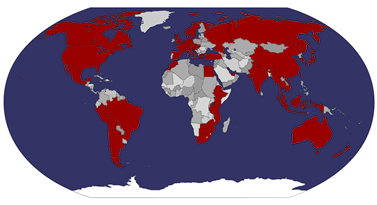
We head in a minibus, seven of us, first to Masyaf, about 60km or an hour’s drive from Hama along the Orontes Valley. The weather is strange – it’s sunny but there’s lots of rain about, and it’s very windy.

The path to the end of the rainbow!
Masyaf Citadel
This is a nice medieval castle sitting just before the mountains in the middle of Masyaf town. Apparently the castle as it would have appeared in the year 1191 is featured in the video game Assassin's Creed!!


As we arrive, rain does too, accompanied by really strong wind, which throws water drops in all directions, a photographic nightmare! Climbing up inside, I pass the ticket office, handing over 75 pounds for a ticket. At the top, the wind howls through the window gaps in the stone, and almost throws one’s balance as you walk about.

The noise…!

The view over the town
All over the castle are holes in the brickwork down to the lower level, presumably for light and ventilation.

Don’t fall down

See the holes dotted about
The castle is certainly pretty, but there’s zero information about it around the castle. Luckily wiki fills in the gaps. The castle dates back to the Byzantine era, and served to protect the trade routes to cities further inland such as Banyas.
The lower layers and foundations of the castle are of Byzantine origin. Later levels were added by the Nizari Ismailis, Mamluks, and Ottomans. Saladin besieged it in May of 1176 but the siege did not last long and it concluded with a truce. Current research indicates it was held by the Assassins at that time. Sounds exciting!



With the wind whipping up spray in all directions, I give up on the outside and head in to explore some of the tunnels.


It’s fun walking about, but would be fascinating to see what it was like when active.


The citadel with our bus parked in front
St. George’s Monastery
Another hour and a half south brings us to St George’s Monastery, not far from Krak, in the town of Meshtaye in north-western Syria's "Valley of the Christians".

The Greek Orthodox monastery, dating 1462 years, i.e. back to 546AD, looks new – the modern church was rebuilt in 1857 and a renovation project had finished recently.

Inside a friendly bearded priest shows us around and explains some of the icons on display, beautiful scenes from the life of Christ.



These doors were stolen and recovered in London by Interpol!
More interestingly, he says he spent a couple of years in Buenos Aires and hated it – he thought there was no room there for an Eastern monk. A different perspective on Argentina, certainly! He also tells us that Muslims come here to worship too, as they have icons with significance to both religions. It’s busiest here on Saint George’s Day and the feast of the elevation of the Holy Cross on September 14.

St. George
We then go down to the original 6th century monastery, which is a bit bare.


Then up to the Old Chapel, from the 13th century, with icons depicting scenes from the life of St. George.

The monastery also holds a manuscript written by the caliph Omar bin al-Khattab, which discussed the relationships between Muslims and Christians. We see a copy in the “salon” before leaving. Definitely our bearded priest is the best bit of the monastery!

Next.. with starters out of the way it’s time for the main course - Krak!
Krak des Chevaliers

Paul Theroux described Krak des Chevaliers as the epitome of the dream of castle of childhood fantasies. TE Lawrence called it “the finest castle in the world”. Krak de Chevaliers, or Qala’at al-Hosn in Arabic, dominates the plain connecting the coast to the Syrian hinterland, known as the Gap of Homs – a strategic spot that was the source of many battles between the Crusaders and Muslims.
To you and me it’s 150 pounds entry – Syrian that is – it’s not that good!
I head up to the first gate, above which is inscribed Arabic.

Inside the approach winds up steeply, making ramming impossible and providing plenty of opportunity for defence.


The first fortress was built by the Emir of Homs in 1031, but in middle of 12th century the Crusaders built what exists today. Despite numerous attacks and sieges, it was never breached – the famous Arabic hero Saladin tried in 1188 but gave up, and in fact in the end it was simply given up by the occupants – Islam held the whole region but for this castle, and so in return for safe passage they surrendered the fort in 1271, despite being technically able to hold out much longer. The fort lost its importance later at the end of the Crusade period – the Ottomans abandoned it in the 19th century.



Incidentally, avid readers may remember that I was puzzled about the existence of two coffins in Saladin’s mausoleum – the mystery has been solved with wiki’s assistance:”Emperor Wilhelm II of Germany donated a new marble sarcophagus to the mausoleum. Saladin was, however, not placed in it. Instead the mausoleum, which is open to visitors, now has two sarcophagi: one empty in marble and one in wood containing the body of Saladin.”


I head up to the top straight away for a marvellous view.


Then I head down to the inner castle, exploring the numerous rooms and passageways.


Apparently Rob and Annette (with a torch) found a secret passageway going down underneath the ramparts right the way (they think) out of the castle, though after following it right down, they found the way blocked at the bottom.
King Edward I of England, whilst on the Ninth Crusade in 1272, apparently saw Krak and used it as an example for his own castles in England and Wales.


The knights resident here were Hospitallers, who were Crusader knights similar to the Knights Templar.



Inside, there is a beautiful Loggia, with a gothic façade.



A chapel, later converted to a mosque, still retains its stone pulpit. Round from the chapel I find the kitchen and interestingly, the oven, a huge round pit which I’m nervous is a well – it’s so dark I can’t see inside it without using my camera flash. Then I find the original medieval toilets, a long row of at least a dozen cubicles!

Medieval johns
These can’t have smelled good with the full complement of 2,000 foot-soldiers using them. Towards the end there were only 200 troops here though. The huge storage rooms (120m long) held enough provisions for five to six years of siege.

Room for a few beers and some pizza

This is where the Cadbury’s Cream Eggs were held. Someone found out.
The two stables could house up to 1,000 horses. The rain starts again, and falls without break until we leave!

Only when I head down to the outside wall, which has 13 towers and a moat, do I realise how impressive and impervious the castle is.

Between inner and outer walls


Not an easy climb


Sheltering from the rain

The moat and a small drawbridge (I suspect for tourists!)
As we drive down from the hill, we have a good view over the Mediterranean in the distance. We are also very close to Lebanon. It seems strange to be seeing the Med when it’s so cold. Syria has a Mediterranean port called Latakia that I won’t have time to visit.
We’re all starving, but the driver doesn’t want to stop, so we end up at Ali Baba’s as soon as we get back. It’s good for fast food, and seconds after ordering food is dropped on to our table. Rob asks for chilli sauce, and so the chap brings along a box of tissues, waving it about saying “chillis”! Apparently the Arabic for tissue is something like “chilli”. I use the internet for a while, and despite Blogger and Facebook being blocked, it’s fast and reliable. Later we meet as a group and head out to Al Atlal restaurant for dinner, followed by a few beers from the bottle shop back at the hotel. The bottle shop was actually closed, but the chap pulled up the shutter and opened up to serve us!




2 comments:
You say that Krak was never taken by seige. In 1271 the fortress, hopelessly undermanned by the Crusaders, was captured by Mameluke Sultan Baibars on April 8 with the aid of heavy catapults and mangonels, at least one of which was later used to attack Acre in 1291. Great to see your photgraphs of Krak
Thanks for the update, Rufus. Much of the history of the area seems to vary according to who is telling it. Was it re-taken by the Crusaders subsequently then, as I had the impression it was peacefully surrendered?
- Regards, Sam
Post a Comment